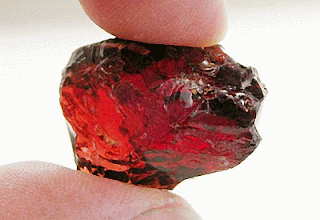The pyralspite garnets form the first group. These are magnesium (Mg), iron (Fe), and manganese (Mn) garnets which all have aluminum (Al) as the second element in their formula. There are three common pyralspite mineral species:
Pyropes are primarily associated with ultramafic igneous rocks (mantle peridotites) and ultrahigh-pressure metamorphic rocks (eclogites) formed during the deep subduction of basaltic seafloor.
Pyrope can be difficult to distinguish from almandine garnets since they form a solid-solution series between each other. Pure pyrope and pure almandine are the exception, typically pyrope has some Fe and almandine has some Mg mixed into the minerals.
Almandine - Fe3Al2(SiO4)3
The name almandine (sometimes called almandite) comes from Alabanda, a location in ancient Asia Minor (modern Turkey). It's also a deep red, sometimes looking purplish, and, as mentioned above, sometimes difficult to distinguish from pyrope.
Almandine is the most common type of garnet and typically the garnet found in garnet schists. The deposits at Gore Mountain, NY (the subject of a future post) are mostly almandine and mined for use as an industrial abrasive.
Spessartine - Mn3Al2(SiO4)3
Spessartine (sometimes called spessartite) is named for Spessart in Bavaria, Germany. Spessartines come in a variety of colors but the most striking are orange.
Spessartines form a solid-solution series with almandine and can thus have Fe mixed into them (they're the reddish spessartines).
Spessartine garnets are most often found in granite pegmatites or Mn-rich metamorphic rocks.
The ugrandite garnets form the second group. These are chromium (Cr), aluminum (Al), and iron (Fe) garnets which all have calcium (Ca) as the first element in their formula. There are three common ugrandite mineral species:
Uvarovite was named after Sergei Semenovitch Uvarov (1765-1855), a Russian mineral collector.
Uvarovite is a rare garnet species but sought out by collectors due to its beautiful emerald-green color.
Uvarovite typically occurs from the metamorphism of silica-rich limestones and associated with serpentine and chromite.
Grossular - Ca3Al2(SiO4)3
The name grossular (also called grossularite) is derived from grossularia, the subgenus name for the gooseberry. Grossular is the most colorful of the garnets with orange, green (called tsavorite), cinnamon brown, or reddish (hessonite) varieties.
Grossular forms in contact-metamorphosed limestones which lack aluminum. Grossular is the Vermont state gemstone, notable specimens come from the Eden Mills are in the northern part of the State.
Andradite was named for the Brazilian mineralogist José Bonifácio de Andrade e Silva (1763-1838).
There are three color varieties of andradite - black (melanite), green (demantoid), and yellow-green (topazolite). Demantoid (the green is from chromium) is very rare and an expensive gemstone.
Andradite also forms in contact-metamorphosed limestones.
Since garnets were values since ancient times as attractive gemstones there are a host of confusing names (some technically incorrect today) referring to all of the different varieties of these six basic garnet species.









Mmm, garnets! Loved this post - I learned more about garnets in 10 minutes than I've learned in the past 30 years.
ReplyDeleteInspired me to pick up and admire my spessartine (such fire in it!) and my lovely bit of garnet schist. Thank you!